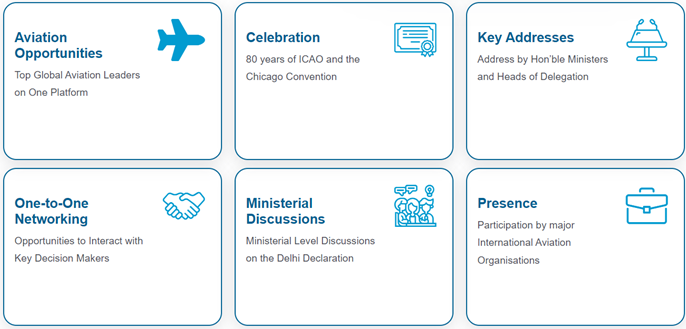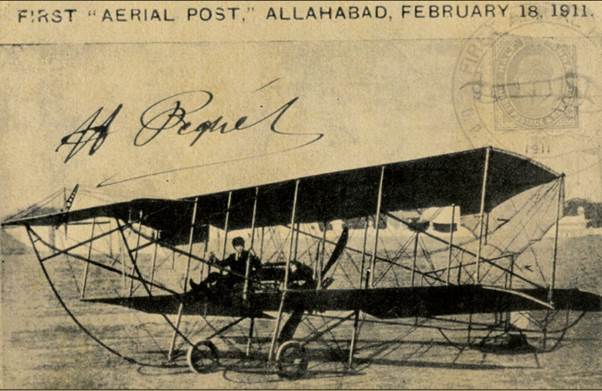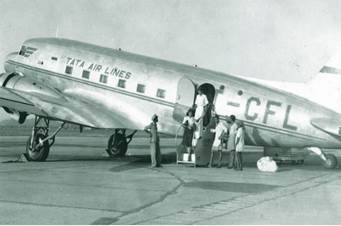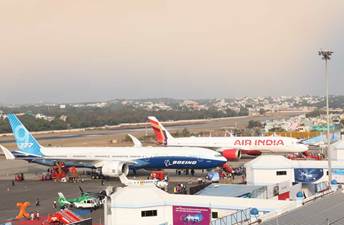Others
India to Host 2nd Asia Pacific Ministerial Conference on Civil Aviation
Posted On:
10 SEP 2024 4:39PM
India's aviation sector has witnessed phenomenal growth, evolving into one of the largest and most dynamic markets in the world. From the humble beginnings of civil aviation in 1911 to the privatization of Air India and the advent of low-cost carriers, the industry has experienced significant milestones. Today, with India hosting the 2nd Asia Pacific Ministerial Conference on Civil Aviation, the country stands at the forefront of global aviation innovation and growth. The government's initiatives, including the UDAN scheme, are reshaping regional connectivity, and rapid infrastructure expansion promises unprecedented growth. As aviation continues to rise as a key driver of economic development and innovation, India's aviation landscape is poised for an exciting future, marked by sustainability, collaboration, and technological advancements.
2nd Asia Pacific Ministerial Conference on Civil Aviation
The 2nd Asia Pacific Ministerial Conference on Civil Aviation is scheduled to be held from 11th to 12th September 2024 at Bharat Mandapam, New Delhi. The event is co-hosted by the International Civil Aviation Organization (ICAO) and the Ministry of Civil Aviation, Government of India. The first Ministerial Conference of the Asia Pacific region was organized in 2018 in Beijing, China. During the first conference, India volunteered to host the second Conference in 2020 however due to the Covid-19 pandemic, the conference was postponed.

Key Highlights
Asia Pacific Ministerial Conference on Civil Aviation is being held against the background of the ever growing and evolving travel needs and requirements of the people living in the region. There is increased focus on exploring airport development and infrastructure that supports burgeoning airline growth with its challenges for the future. This event brings together top aviation decision makers and policy drivers from across the globe to discuss and deliberate on cooperation and coordinated approach going forward and is an ideal opportunity to identify new opportunities and forge new relationships in the aviation sector.
India is the fastest growing aviation market in the world and is currently the 3rd largest in the domestic segment. In the last decade, the number of aircraft in India has increased from 400 to more than 800 and airports have exponentially grown from 74 to 157. The government's ambitious initiatives like UDAN (Ude Desh ka Aam Nagrik) have enhanced regional connectivity, ensuring that even remote areas are integrated into the aviation network creating a robust ecosystem for unprecedented development.
The result is that the aviation sector is on a steep growth trajectory and has been one of the world leaders in surpassing the pre-covid levels of domestic and international travellers. This tremendous growth is exemplified by Indian Airlines ordering more than 1200 aircrafts in the last year alone.
History of Indian Aviation

Civil aviation in India took flight in 1911 with the inauguration of the first commercial flight between Allahabad and Naini. Spearheaded by J.R.D. Tata, Tata Airlines (now Air India) commenced operations in 1932, marking the onset of scheduled air services. Initially serving cities like Mumbai, Chennai, and Kolkata, the sector saw significant government involvement post-independence, leading to the nationalization of airlines and the formation of Air India and Indian Airlines. A pivotal moment in Indian aviation was marked by Sarla Thakral, who became the first woman to fly an aircraft and obtain a pilot's license.


India became a member of the International Civil Aviation Organization (ICAO) on March 30, 1947, enabling participation in global aviation initiatives promoting safety, efficiency, and international collaboration. Over the years, the sector witnessed the emergence of private airlines post-liberalization in the 1990s, followed by the rise of low-cost carriers in the 2000s, revolutionizing air travel accessibility.
Key Milestones in the Evolution of Indian Aviation
- The roots of Indian aviation date back to 1911 when Monseigneur Piguet piloted the first commercial flight from Allahabad to Naini, initiating the world's maiden airmail service. Tata Airlines (now Air India) further solidified this journey in 1932, pioneering scheduled air services.
- The dawn of the jet age in 1960 saw Air India introducing the Boeing 707, Gauri Shankar, becoming Asia's first jet-equipped airline. By 1962, it operated the world's first all-jet fleet. The acquisition of Boeing 747s in 1971 elevated Air India's stature as a luxury carrier, setting new standards in international travel.
- The early 1990s marked a significant turning point with the deregulation of India's aviation sector. The Air Corporations (Transfer of Undertakings and Repeal) Act of 1994 paved the way for private players like Jet Airways and Air Sahara, to enter the aviation market.
- The early 2000s witnessed a transformative period with the emergence of low-cost carriers such as Air Deccan, SpiceJet, and IndiGo. This democratized air travel, making it more accessible to a broader spectrum of travelers and fueling India's ascent as the world's third-largest aviation market.
- In 2022, Air India's privatization under the Tata Group marked a significant milestone. This move injected fresh vigor into the aviation landscape, promising enhanced services and connectivity as India's aviation sector continues to evolve and soar to new heights.
Conclusion
The future of Indian aviation is set for a dynamic evolution marked by rapid growth, innovation, and modernization. The government's strategic focus on enhancing infrastructure, training, and policy reforms through initiatives like UDAN, alongside advancements in technology and sustainable practices, will contribute to a safer, more efficient, and eco-friendly aviation ecosystem. In addition, Advanced Air Mobility (AAM) stands poised to revolutionize short to medium distance air travel, alleviating urban congestion and enhancing connectivity. The expanding collaboration between the public and private sectors signal a transformative era for Indian aviation, positioning it as a key driver of economic development and enhanced connectivity. The Indian aviation sector is set to reach unprecedented heights in the coming years.
References
https://pib.gov.in/PressReleaseIframePage.aspx?PRID=2053262.
https://www.apacmc.in/
https://x.com/MoCA_GoI/status/1832691299407012119
Click here to see in PDF:
Santosh Kumar/ Sarla Meena/Aswathy Nair
(Explainer ID: 152118)
आगंतुक पटल : 2163
Provide suggestions / comments